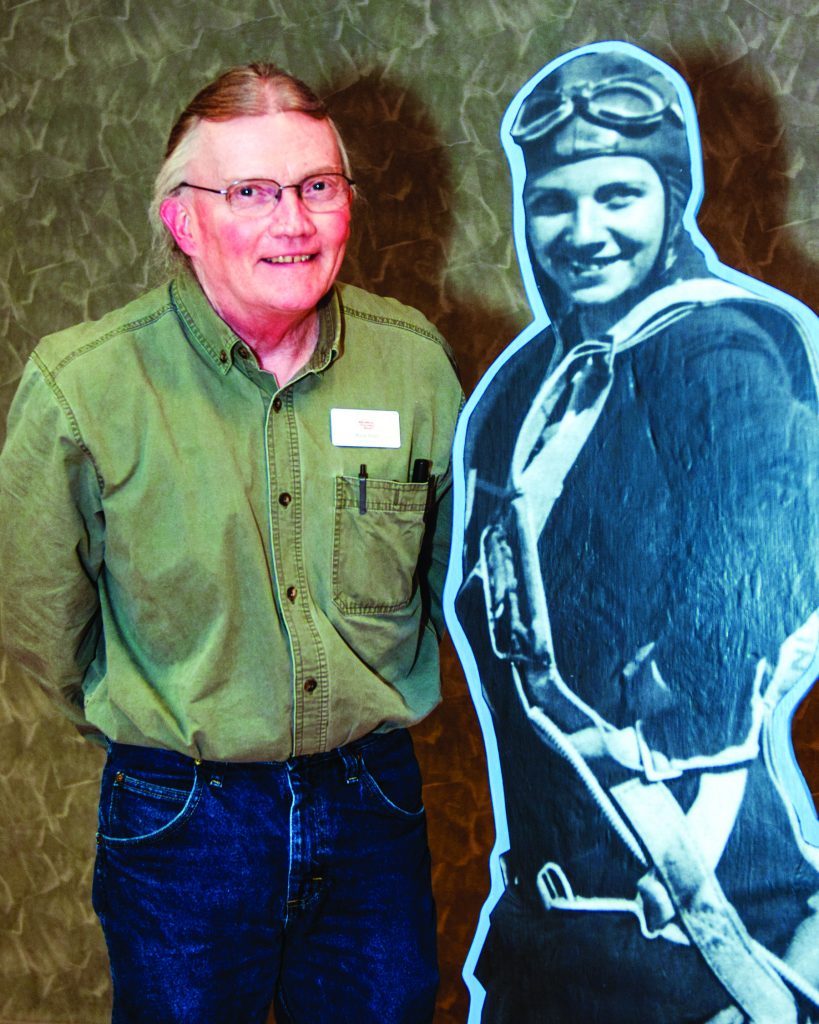
Nancy Edmonds Hanson
hansonnanc@gmail.com
She was, briefly, a “rock star” of her time. “Pilots were the superstars of their day between the two world wars,” asserts archivist Mark Peihl. And one of the greatest, who flew fast and high before her tragic end, was Clay County’s Florence Klingensmith.
Now, 100 years after her family moved to town and she enrolled in Moorhead High School, the story of the little-known native – so famous in her own day – is being restored by a groundbreaking book and a season of community-wide study of her legend. Author Keith O’Brien’s New York Times best-seller Fly Girls tells the story of Florence and four of her contemporaries, including Amelia Earhart, in their quest to prove that women could fly as fast as any male pilot – maybe better.
Peihl, chief researcher for the Historical and Cultural Society of Clay County, shared her story last week at the group’s annual meeting. He’ll be giving the same presentation in public and college libraries around Fargo-Moorhead later this year as the cities tackle Fly Girls as their eighth “One Community, One Book” selection. It features a community book discussion, film screenings, cultural exhibits and other events, including a visit by the author Oct. 28 at the Fargo Air Museum.
Preparing for the illustrated talk he’ll be sharing in many venues, Mark researched publications of the day as well as Clay County seniors who knew Florence and her three siblings. The Gunderson children started at Oak Mound School near their family farm three miles southwest of Kragnes, where their grandparents had been among the earliest settlers. Their father Gustav served as its janitor and drove the horse-drawn wagon that served as a school bus.
The family moved into Moorhead in 1918. Mark has gathered memories of Moorheaders who remember Florence and her older brother, among them Ingvald Stensland, Clarence Simonson, Evelyn Gesell, Oliver Sondrall and Marion Gillespie. Stensland described Florence in particular as “spetakkul,” a Norwegian word that roughly translates to “rambunctious.” “They were daring and fearless,” he told the historian, “but good kids.”
Author O’Brien quotes Ingvald’s assessment as title of a chapter on Florence, who became known by the nickname Tree Tops.. He spent several months in late 2016 in Moorhead going through the historical societies records and drawing on Mark’s research.
Florence was athletic and attractive – a 5 foot 4 inch blue-eyed blonde. Her contemporaries reported she’d do anything on a dare, from reckless ski jumping to bombing up and down Center Avenue on a motorcycle to catching a free ride on Fargo-Moorhead streetcars, not inside but hanging onto the cowcatcher in the front. She longed to fly, striking an edgy bargain for her first plane ride during the Interstate Fair in 1921: She’d pose on an airplane’s wing in return for the flight. “I was scared to death,” she said later. “But now I’m crazy to fly.”
She left high school that year, taking a decidedly earthbound job at the Pantorium, a dry cleaner in Fargo. She was hired to deliver dry cleaning but demoted for too many speeding tickets. There she met and married a pants presser, Charles Klingensmith; while she kept his name, the marriage lasted only two years.
Her smoldering urge to take flight was fanned into flame in 1928, when national hero Charles Lindbergh visited Fargo. She waved like crazy as he paraded down Broadway … but he failed to wave back. Insulted by the perceived slight, she vowed to show him that he wasn’t so important or the only one who could fly a plane. “I’ll show him a woman can handle one of these things, too.”
But money was a problem. She couldn’t afford a plane of her own; instead, she traded stunts like wing walking and parachute drops for the occasional lesson. On her first jump, she was unconscious by the time she reached the ground; but when her head cleared, she climbed aboard for another.
By the end of the year she’d become the only woman among 400 male students at Hanson Mechanical Trade School in downtown Fargo. As an accomplished mechanic, she got a job at Fargo’s new airfield, trading her labor for flying lessons from Edwin Canfield – the same pilot for whom she’d passed out parachuting. She became North Dakota’s first licensed female pilot in 1929. But buying her own plane was still out of reach. Finally she convinced several Fargo businessmen to put up $3,000 to buy the aircraft she christened Miss Fargo, promising to promote the community as she competed in air races.
Female pilots were mostly considered a punch line among the manly men who manned airplane cockpits, Mark notes. Debate raged over whether they were fit to fly, with their lady hormones and delicate sensibilities. O’Brien’s Fly Girls details the mockery she faced as an “aviatrix,” along with four other women who dared to compete, including her contemporary Amelia Earhart. Nevertheless, she persisted, acquiring faster planes and then tuning them herself to coax even more horsepower.
Her daring made her a stand-out as a stunt flyer at air shows – the greatest spectacles of the day, sometimes drawing in excess of 100,000 spectators. She set the female record for inside loop-the-loops in 1931 at 1,078. Later she noted, “I could have beaten the male record of 1,400, too, if I hadn’t been running out of gas.”
Air races, though, were the first draw. Few permitted female competitors, limiting them to flying against each other. She placed fourth in her first race in 1928 and, in 1931, won four events at the National Air Races in Ohio, nabbing $70,000 in prize money. Soon after she placed second among a field of eight, all the rest of them male, and was finally being recognized as a real contender. Her knowledge of planes, inside and out, gave her an edge other pilots could only envy.
But she kept pushing it. In 1933 she acquired a Gee Bee Sportster, a racing plane already known as a nimble but risky machine – lightweight, fast as lightning and given to crashing when the fabric covering tore on its wooden wings. Not satisfied, she swapped out her engine to double its horsepower.
That was the airplane she was to fly in the International Air Race during the Chicago World’s Fair that year. The 29-year-old had already taken second in a female-only race that year. Now she was competing against men in the much-publicized race. Flying at speeds well in excess of 200 mph, they competed on a triangular course, cutting around three pylons a total of 12 times. She was in third place and coming up strong on her eighth lap when the fabric ripped on her right wing, causing it to nosedive into the ground.
Observers said the young pilot could have saved herself by parachuting free. That would have left her plane like an unguided missile, though, likely to plunge into the crowd or the city below. Instead, she attempted to regain control … riding it to the end as it buried its nose in a field. She was probably killed on impact.
Ironically, instead of heralding her bravery, her death was debated as proof that women shouldn’t fly. Some questioned whether she might have had her period. But the next year a male pilot was killed in nearly identical accident. Clearly the Bee Gee aircraft was flawed. After a year-long ban, women pilots were allowed to return to the air, carrying on the tradition for which the Moorhead woman had given her life.
Her body was shipped back to Moorhead for burial, with the Fargo businessmen who’d bankrolled her first plane serving as her pallbearers. Her simple grave at Oak Mound Cemetery is marked today by a monument designed by members of the Oak Mound 4-H Club.


